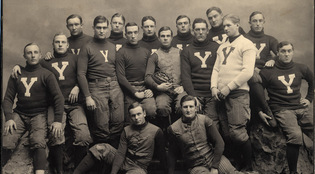 loading
loading
Gay at Yale Manuscripts & ArchivesIn a 1902 portrait of the football team, the players draped their arms over each other. But men soon began to avoid such intimacy, for fear of being called queer. In later photos, Yale football players kept their arms to their sides and hands on their knees. View full imageThe policing of homosexuality became especially severe in the mid-twentieth century. The strongest anti-gay voices demonized homosexuals as child molesters, sex degenerates, sex fiends, and sex murderers. Police raids on lesbian and gay bars became common, and at the height of McCarthyism in the early 1950s the State Department dismissed more gay people than communists. This repression had powerful effects on the emerging gay world, nationwide and at Yale. Even as more men and women began to identify as gay and to develop a group life together, they learned they had to keep their gay meeting places carefully hidden, and to keep their own homosexuality a secret from outsiders in order to secure the kind of work and respect they wanted. By the 1940s and '50s, much of gay life had been pushed underground. Still, students who found their way into the underground discovered a more vibrant gay scene at Yale than they -- or we -- might have expected. The music and drama schools were the largest and most visible centers of gay life on campus, since they drew creative and unconventional souls who were less likely to care about sexual respectability than, say, young businessmen or lawyers. Some undergrads gravitated toward those gay scenes, or found their equivalent in the Yale Dramat and other theater and a cappella groups. (Indeed, the exceptional vibrancy of theater, music, and other arts at Yale may long have attracted disproportionately large numbers of gay students.) Groups of friends visited New York together, where there were dozens of gay bars and restaurants clustered in four distinct gay neighborhoods. Some students went to the handful of bars in New Haven -- an all-out gay bar called Pirelli's, and two "normal" bars (the Taft Hotel bar and George & Harry's) where gay men met more discreetly. But students could also find gay life in the college itself, if they knew where to look. One reliable account reports that in the 1930s at least one Yale fraternity was secretly all gay, and in the '40s and '50s, when students could still choose their residential college, Jonathan Edwards College developed a gay reputation. Bolder students even threw all-gay parties in their rooms. One psychiatrist who counseled these students in the 1940s commented on the enormous anti-gay pressures they faced. All of them felt the pressure to date women, to suppress any sign of effeminacy, and to put on a straight face to the world. But he also noted that they responded to those pressures in diverse ways, some capitulating to the expectations they would marry after college, others moving to New York to create a life of their own. The trouble for many gay or questioning students, though, was that gay life was so carefully hidden they couldn't find it. A story the AIDS activist and playwright Larry Kramer '57 tells about his Yale days encapsulates the situation. He has often told how, lonely and despondent, he tried to commit suicide during his freshman year in 1953. The university insisted that he start seeing a psychiatrist, Clements Fry, and during his first visit Larry told Fry about meeting two other freshmen, Jim and Peter, who'd already moved in together in their freshman dorm. They'd painted the room all black and removed everything but a single mattress, also black, which they clearly shared, and an elegant coffee table accented with a single rose. They played a record by the black British cabaret singer (and gay favorite) Mabel Mercer as they served him tea. Fry's reaction, Larry recalls, was: "I wouldn't see those guys anymore if I were you." This, in effect, was Fry's -- and Yale's -- standard line. Fry realized there were many self-accepting gay students and faculty at Yale, men who, as Fry wrote in 1945, "work through quickly to an acceptance of their homosexuality and of sexual activity" and who "contribute greatly" to society. Unlike McCarthy and the Eisenhower administration officials who tried to purge homosexuals from the federal government in the 1950s, neither Fry nor other Yale administrators tried to purge gays from the university. But they did worry about gays seducing impressionable young men into the homosexual life. As Fry wrote, "Within the university [these homosexual students] acted as a magnet, attracting other homosexuals and exercising an influence over those who were not consciously homosexual or whose sex lives were unorganized . . . . They constituted a threat to others." To counter this so-called threat, he discouraged students like Larry from associating with gays, and Yale generally enforced a code of silence about homosexuality. Professors knew they needed to remain "discreet" in their teaching as well as their personal lives if they wished to flourish here. And almost all gay people realized an unequal social contract had been imposed upon them. It allowed them to remain productive members of the Yale community, but only so long as they kept their homosexuality a secret from outsiders. "Don't ask, don't tell" ruled the land. As intended, the great damage wrought by this unequal contract was that many, many students struggling to understand and come to terms with their sexuality never found other people like themselves, never knew such people even existed at Yale. And many heterosexual students accepted the demonization of homosexuals because they never realized they knew any. Anti-gay policing reproduced itself this way across the country.
|
|